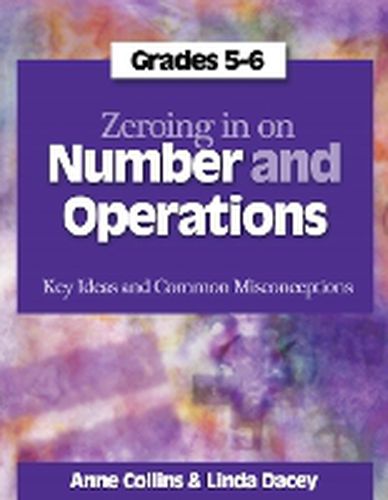Readings Newsletter
Become a Readings Member to make your shopping experience even easier.
Sign in or sign up for free!
You’re not far away from qualifying for FREE standard shipping within Australia
You’ve qualified for FREE standard shipping within Australia
The cart is loading…






When you talk with students about their number sense and computational skills, you’re bound to uncover some surprising gaps in their understanding. Knowing how to identify and bridge those gaps is essential for helping students at all levels advance as mathematical thinkers.
The Zeroing in on Number and Operations series, which aligns with the Common Core State Standards and the NCTM Sandards and Focal Points, features easy-to-use tools for teaching key concepts in number and operations and for addressing common misconceptions. Sharing the insights they’ve gained through decades of mathematics teaching and research, Anne Collins and Linda Dacey help you focus on what students really need to know and understand at each grade level.
The 30 modules in the grades 5 and 6 flipchart are designed to engage all students in mathematical learning that develops conceptual understanding, addresses common misconceptions, and builds key ideas essential to future learning. The modules are organized into three sections: Whole Numbers and Operations; Fractions; and Decimals. Each module begins with the identification of its Mathematical Focus and the Potential Challenges and Misconceptions associated with those ideas. In the Classroom then suggests instructional strategies and specific activities to implement with your students. A section on Meeting Individual Needs offers ideas for adjusting the activities to reach a broader range of learners. Each activity is supported by a reproducible, and References/Further Reading provides resources for enriching your knowledge of the topic and for gathering more ideas.
At grades 5 and 6, the authors focus on the key ideas that are essential at these levels:
Place value to billions and thousandths Divisibility rules Division with single and multidigit divisors Order of operations to include parentheses Multiples and factors to include least common multiple and greatest common factors Rational numbers including equivalence between and among fractions and decimals Fraction as ratio including the difference between an additive and multiplicative relation Operations on rational numbers
$9.00 standard shipping within Australia
FREE standard shipping within Australia for orders over $100.00
Express & International shipping calculated at checkout
When you talk with students about their number sense and computational skills, you’re bound to uncover some surprising gaps in their understanding. Knowing how to identify and bridge those gaps is essential for helping students at all levels advance as mathematical thinkers.
The Zeroing in on Number and Operations series, which aligns with the Common Core State Standards and the NCTM Sandards and Focal Points, features easy-to-use tools for teaching key concepts in number and operations and for addressing common misconceptions. Sharing the insights they’ve gained through decades of mathematics teaching and research, Anne Collins and Linda Dacey help you focus on what students really need to know and understand at each grade level.
The 30 modules in the grades 5 and 6 flipchart are designed to engage all students in mathematical learning that develops conceptual understanding, addresses common misconceptions, and builds key ideas essential to future learning. The modules are organized into three sections: Whole Numbers and Operations; Fractions; and Decimals. Each module begins with the identification of its Mathematical Focus and the Potential Challenges and Misconceptions associated with those ideas. In the Classroom then suggests instructional strategies and specific activities to implement with your students. A section on Meeting Individual Needs offers ideas for adjusting the activities to reach a broader range of learners. Each activity is supported by a reproducible, and References/Further Reading provides resources for enriching your knowledge of the topic and for gathering more ideas.
At grades 5 and 6, the authors focus on the key ideas that are essential at these levels:
Place value to billions and thousandths Divisibility rules Division with single and multidigit divisors Order of operations to include parentheses Multiples and factors to include least common multiple and greatest common factors Rational numbers including equivalence between and among fractions and decimals Fraction as ratio including the difference between an additive and multiplicative relation Operations on rational numbers